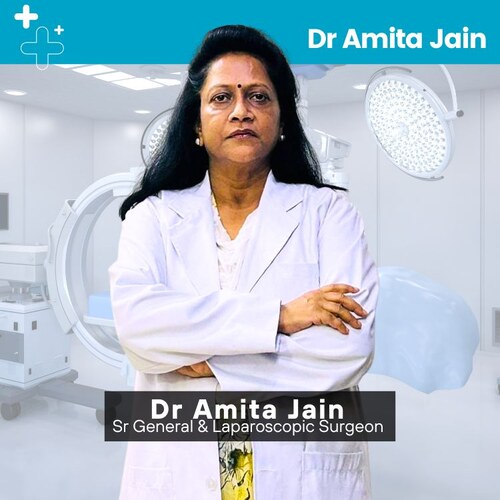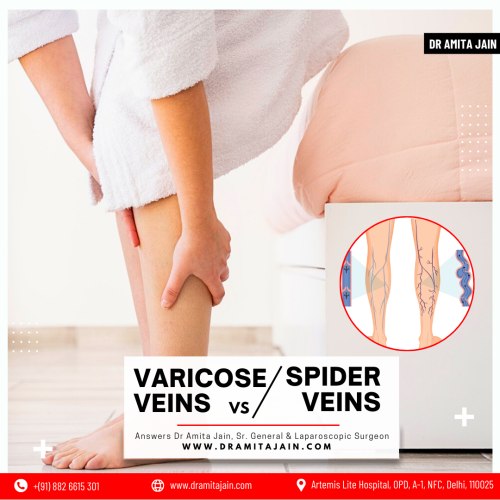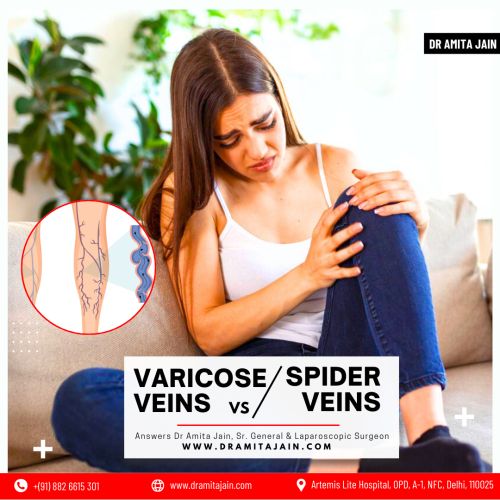We’ve all heard the saying, “Health is wealth.” No matter how well we eat, how regularly we exercise, or how carefully we take care of ourselves, some health concerns still show up unexpectedly. Varicose veins and spider veins are prime examples — often appearing quietly, sometimes because of lifestyle habits, but just as often due to factors beyond our control, such as genetics, age, hormonal changes, or even the nature of our work.
At first glance, many people think varicose veins and spider veins are the same thing. While they share similarities, both are visible veins that often appear on the legs; they differ significantly in their appearance, severity, and impact on health.
Here, Dr Amita Jain, an eminent general and laparoscopic surgeon and a specialist doctor for varicose veins treatments in Delhi, explains how these two conditions differ, and what you can do about them.
What are Varicose Veins and Spider Veins?
Varicose Veins are enlarged, swollen, twisted veins that appear blue, red, or skin-coloured. They often look rope-like and bulge just beneath the skin.
Spider Veins (also called thread veins) are much smaller, superficial blood vessels visible near the skin’s surface. They resemble fine tree branches or spider webs and are usually red, blue, or purple. Unlike varicose veins, they don’t cause the skin to bulge.
Where They Appear
Varicose veins are most common on the thighs, calves, behind the knees, and near the ankles. In pregnancy, they may also develop around the inner thighs, pelvic region, or buttocks.
Spider veins can appear on the legs and face, but may also show up on the feet, ankles, or other parts of the body.
Symptoms
Varicose veins can cause discomfort — aching, heaviness, burning, itching, swelling, and sometimes skin damage such as dryness, discolouration, and ulcers near the ankles. In more advanced cases, they can lead to bleeding, blood clots, and chronic venous insufficiency.
Spider veins are usually painless and mainly a cosmetic concern. In rare cases, they may cause mild aching or a burning sensation.
Why Varicose and Spider Veins Happen?
Varicose veins develop when the one-way valves in the veins — which normally keep blood flowing toward the heart — become weak or damaged. This causes blood to pool, stretching and twisting the veins. Common contributing factors include:
- Age-related wear and tear on the vein valves
- Hormonal changes in women (pregnancy, menopause)
- Extra pressure from pregnancy or obesity
- Prolonged sitting or standing
Spider veins have different but overlapping causes. They often run in families, and can be triggered or worsened by:
- Long-term sun exposure or tanning, which weakens vessel walls
- Hormonal fluctuations during puberty, pregnancy, menopause, or with certain medications
- Prolonged standing or sitting
- Lifestyle factors such as smoking or excess body weight
- Certain skin or connective tissue disorders
Treatment Options
For Varicose Veins, early management focuses on lifestyle measures such as leg elevation, compression stockings, and maintaining a healthy weight. If these don’t help, minimally invasive procedures like sclerotherapy, laser therapy, endovenous ablation, or ambulatory phlebectomy can seal or remove affected veins. In severe cases, surgical techniques like vein ligation and stripping or endoscopic vein surgery may be necessary.
For Spider Veins, treatment is mainly cosmetic. Sclerotherapy — injecting a special solution to close the vein — is a common option. Laser therapy can also be effective, especially for facial veins. Both treatments require some post-procedure care, such as wearing compression stockings and avoiding sun exposure for a few weeks.
The key difference is simple: varicose veins are larger, bulging, and may cause discomfort, while spider veins are smaller, web-like, and usually painless. Both can result from genetic, hormonal, and lifestyle factors, and both can be treated effectively with the right approach.
If you notice visible veins on your legs or face, it’s worth consulting a specialist like Dr. Amita Jain, who can assess the severity, explain your options, and guide you toward the most effective treatment. With timely care, you can not only improve your health but also restore comfort and confidence in your appearance.

Dr Amita Jain is one of India’s most distinguished and experienced female surgeons, known for her unmatched expertise in general and laparoscopic surgery. With over 29 years of surgical excellence, Dr Amita Jain has built a reputation for precision, compassionate care, and advanced surgical techniques.
Dr Amita Jain has successfully performed a wide range of complex general surgeries, including both open and minimally invasive procedures, with a strong focus on trauma care, onco-surgical techniques, and reconstructive surgeries. Her areas of specialisation include (including Gallbladder stone removal, appendix removal, hernia repair surgery, piles and fissure surgeries). She was the Professor of Surgery at the Army College of Medical Sciences and Base Hospital, Delhi Cantt. In 1994, she was commissioned asa Surgeon under the United Nations Mission in Congo. From 2020 to 2022, she worked with Bansals Hospital. Currently, Dr Amita Jain is the Senior General and Laparoscopic Surgeon at Rainbow Children Hospitals (Malviya Nagar, Delhi), Artemis Lite: Multi-Speciality Care Hospital (New Friends Colony, New Delhi) and at Rosewalk – Luxury Maternity Hospital in Delhi (Panchsheel Park, Delhi)
Call Us at +(91) 882-6615301

